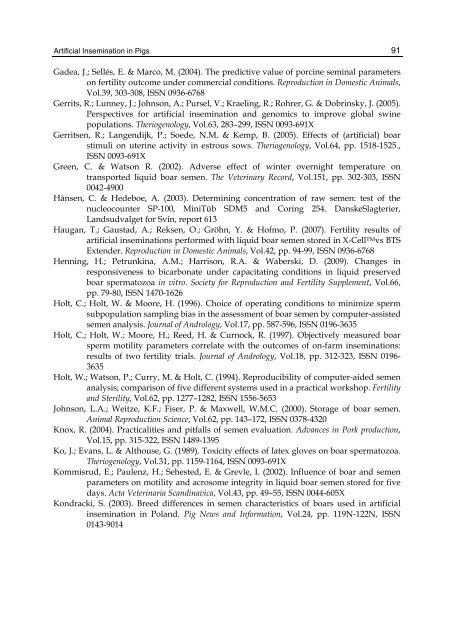ARTIFICIAL INSEMINATION IN FARM ANIMALS - Phenix-Vet
ARTIFICIAL INSEMINATION IN FARM ANIMALS - Phenix-Vet
ARTIFICIAL INSEMINATION IN FARM ANIMALS - Phenix-Vet
Create successful ePaper yourself
Turn your PDF publications into a flip-book with our unique Google optimized e-Paper software.
Artificial Insemination in Pigs 91Gadea, J.; Sellés, E. & Marco, M. (2004). The predictive value of porcine seminal parameterson fertility outcome under commercial conditions. Reproduction in Domestic Animals,Vol.39, 303-308, ISSN 0936-6768Gerrits, R.; Lunney, J.; Johnson, A.; Pursel, V.; Kraeling, R.; Rohrer, G. & Dobrinsky, J. (2005).Perspectives for artificial insemination and genomics to improve global swinepopulations. Theriogenology, Vol.63, 283–299, ISSN 0093-691XGerritsen, R.; Langendijk, P.; Soede, N.M. & Kemp, B. (2005). Effects of (artificial) boarstimuli on uterine activity in estrous sows. Theriogenology, Vol.64, pp. 1518-1525.,ISSN 0093-691XGreen, C. & Watson R. (2002). Adverse effect of winter overnight temperature ontransported liquid boar semen. The <strong>Vet</strong>erinary Record, Vol.151, pp. 302-303, ISSN0042-4900Hànsen, C. & Hedeboe, A. (2003). Determining concentration of raw semen: test of thenucleocounter SP-100, MiniTüb SDM5 and Coring 254. DanskeSlagterier,Landsudvalget for Svin, report 613Haugan, T.; Gaustad, A.; Reksen, O.; Gröhn, Y. & Hofmo, P. (2007). Fertility results ofartificial inseminations performed with liquid boar semen stored in X-Cell TM vs BTSExtender. Reproduction in Domestic Animals, Vol.42, pp. 94-99, ISSN 0936-6768Henning, H.; Petrunkina, A.M.; Harrison, R.A. & Waberski, D. (2009). Changes inresponsiveness to bicarbonate under capacitating conditions in liquid preservedboar spermatozoa in vitro. Society for Reproduction and Fertility Supplement, Vol.66,pp. 79-80, ISSN 1470-1626Holt, C.; Holt, W. & Moore, H. (1996). Choice of operating conditions to minimize spermsubpopulation sampling bias in the assessment of boar semen by computer-assistedsemen analysis. Journal of Andrology, Vol.17, pp. 587-596, ISSN 0196-3635Holt, C.; Holt, W.; Moore, H.; Reed, H. & Curnock, R. (1997). Objectively measured boarsperm motility parameters correlate with the outcomes of on-farm inseminations:results of two fertility trials. Journal of Andrology, Vol.18, pp. 312-323, ISSN 0196-3635Holt, W.; Watson, P.; Curry, M. & Holt, C. (1994). Reproducibility of computer-aided semenanalysis; comparison of five different systems used in a practical workshop. Fertilityand Sterility, Vol.62, pp. 1277–1282, ISSN 1556-5653Johnson, L.A.; Weitze, K.F.; Fiser, P. & Maxwell, W.M.C. (2000). Storage of boar semen.Animal Reproduction Science, Vol.62, pp. 143–172, ISSN 0378-4320Knox, R. (2004). Practicalities and pitfalls of semen evaluation. Advances in Pork production,Vol.15, pp. 315-322, ISSN 1489-1395Ko, J.; Evans, L. & Althouse, G. (1989). Toxicity effects of latex gloves on boar spermatozoa.Theriogenology, Vol.31, pp. 1159-1164, ISSN 0093-691XKommisrud, E.; Paulenz, H.; Sehested, E. & Grevle, I. (2002). Influence of boar and semenparameters on motility and acrosome integrity in liquid boar semen stored for fivedays. Acta <strong>Vet</strong>erinaria Scandinavica, Vol.43, pp. 49–55, ISSN 0044-605XKondracki, S. (2003). Breed differences in semen characteristics of boars used in artificialinsemination in Poland. Pig News and Information, Vol.24, pp. 119N-122N, ISSN0143-9014










